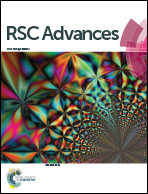Liquid exfoliation of layered metal sulphide for enhanced photocatalytic activity of TiO2 nanoclusters and DFT study†
Abstract
Layered metal sulphides (LMSs) such as MoS2, WS2 and SnS2 have attracted much attention in the field of photocatalysis due to their excellent properties. Herein, a facile and effective liquid exfoliation solvothermal method for fabricating TiO2/LMS (LMS = MoS2, WS2 or SnS2) photocatalysts has been developed. The optimum molar ratio of Ti–Mo, Ti–W and Ti–Sn was determined to be 50 : 0.8, 50 : 0.1 and 50 : 0.1, respectively. The optical properties of TiO2/LMS with a matching solar spectrum contribute to converting the solar energy to chemical energy by photon-driven photocatalytic reactions. The combined effect of liquid exfoliation and solvothermal reforming has been demonstrated as an effective method to obtain high efficiency photocatalysts using bulk metal sulphides as sensitizers. The binding site of TiO2 and the LMS at the interface of a composite photocatalyst was investigated by the density functional theory (DFT) method at a molecular cluster level, and the calculation results showed that firm structures were formed at the interfaces of TiO2 nanoparticles and the LMS. The photocatalytic activity evaluation of TiO2/LMS showed that the LMS played the crucial role in separation of photogenerated e−/h+ pairs and utilization of photons for enhancing the photocatalytic activity of TiO2. The study of the electron transfer mechanism indicated that the synergetic effect of superoxide radicals (·O2−) and hydroxyl radicals (·OH) plays the leading role in the dye degradation process.


 Please wait while we load your content...
Please wait while we load your content...